
auto body repair tools and equipment pdf
Auto body repair requires specialized tools and equipment to ensure precise and efficient work. Essential tools include wrenches, pliers, and Torx sockets, while materials like metal and fiberglass necessitate specific tools for proper handling. A well-organized toolbox and the right equipment are crucial for achieving professional results in any automotive repair project.
Importance of Proper Tools in Auto Body Repair
Proper tools are essential for ensuring safety, efficiency, and precision in auto body repair. They prevent damage to vehicles and help achieve professional-grade results. The right tools, such as Torx sockets and 3M auto-centering devices, are designed for specific tasks, like spot weld removal or metal alignment. Using appropriate equipment reduces the risk of errors and enhances the quality of repairs. Additionally, specialized tools for materials like fiberglass and metal ensure durability and longevity of the vehicle. Investing in high-quality tools is crucial for both amateur and professional technicians to maintain standards and avoid costly mistakes.
Overview of Common Tools and Equipment
Common tools in auto body repair include wrenches, pliers, hammers, and dollies. Power tools like drills and impact wrenches are also essential. Specialized equipment such as dent removal tools and frame straightening machines are used for specific tasks. Materials like metalworking supplies and adhesives are integral to repairs. Safety gear, including PPE and ventilation systems, is vital. Proper tool organization, such as a rollaway toolbox, enhances efficiency. These tools and materials ensure that technicians can handle various repair tasks effectively, from minor dents to major structural work, while maintaining safety and precision.
Safety Considerations
Safety is paramount in auto body repair. Personal protective equipment (PPE) like gloves, goggles, and respirators is essential to protect against hazards. Proper ventilation systems are critical to prevent inhalation of harmful fumes. Fire extinguishers and emergency equipment should always be accessible. Regular inspection of tools and equipment ensures they are in safe working condition. Proper storage of materials and tools prevents accidents. Adhering to safety protocols minimizes risks and ensures a secure working environment for technicians. Prioritizing safety not only protects individuals but also maintains the integrity of the repair process.
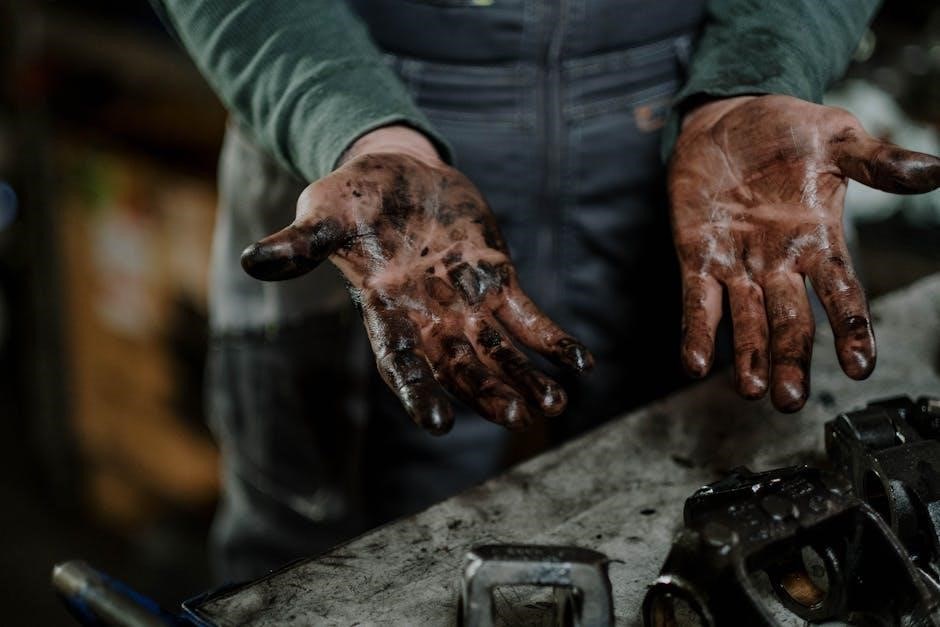
Essential Hand Tools for Auto Body Repair
Wrenches, pliers, hammers, and dollies are fundamental for metalwork and panel shaping. Screwdrivers and punches aid in hardware removal. These tools are vital for precise auto body repair tasks.
Wrenches and Sockets
Wrenches and sockets are indispensable in auto body repair, offering versatility for various tasks. A combination wrench set, including metric sizes from 7mm to 19mm, is essential for bolt and nut adjustments. Hex wrench sets, ranging from 1/16 to 3/8 inches, are ideal for precise fittings. Torx sockets, from T8 to T55, are crucial for modern vehicles with specialized fasteners. These tools enable technicians to handle diverse materials and ensure secure connections, making them fundamental for efficient and accurate repairs in any automotive project.
Pliers and Punches
Pliers and punches are essential for gripping, bending, and shaping materials in auto body repair. Needle-nose pliers are ideal for reaching tight spaces, while locking pliers provide a secure grip for complex tasks. Punches are used to create precise holes or remove old rivets and fasteners. These tools are crucial for working with metal, fiberglass, and other materials, ensuring accurate and efficient repairs. They complement wrenches and sockets by offering versatility in handling various fastening and shaping challenges, making them indispensable in any auto body repair toolkit.
Hammers and Dollies
Hammers and dollies are indispensable in auto body repair for shaping and restoring metal panels. A ball-peen hammer is often used for metalworking, while a sledgehammer is employed for heavier tasks. Dollies, made of steel or plastic, serve as anvils to support panels during shaping. They come in various sizes to accommodate different repair areas. These tools are crucial for removing dents, aligning body panels, and ensuring a smooth finish. Proper use of hammers and dollies requires skill to avoid damaging the vehicle’s structure, making them essential for achieving professional-grade repairs in any auto body shop.
Power Tools for Advanced Repair
Power tools like welders, sanders, and grinders are essential for advanced auto body repair. They efficiently handle metal fusion, surface smoothing, and material removal, enhancing repair efficiency and precision.
Welding Equipment
Welding equipment is crucial for metal fusion in auto body repair, enabling strong, durable joints. Common types include MIG, TIG, and arc welders, each suited for specific materials. Accessories like welding helmets, gloves, and wire feeders ensure safety and precision. Proper ventilation and protective gear are essential to prevent fumes and sparks exposure. Advanced tools, such as auto-centering spot weld drills, simplify removal and repair of factory welds. Welding equipment is vital for restoring structural integrity, especially in collision repairs involving steel or aluminum body panels. Regular maintenance and calibration ensure optimal performance and safety in the repair process.
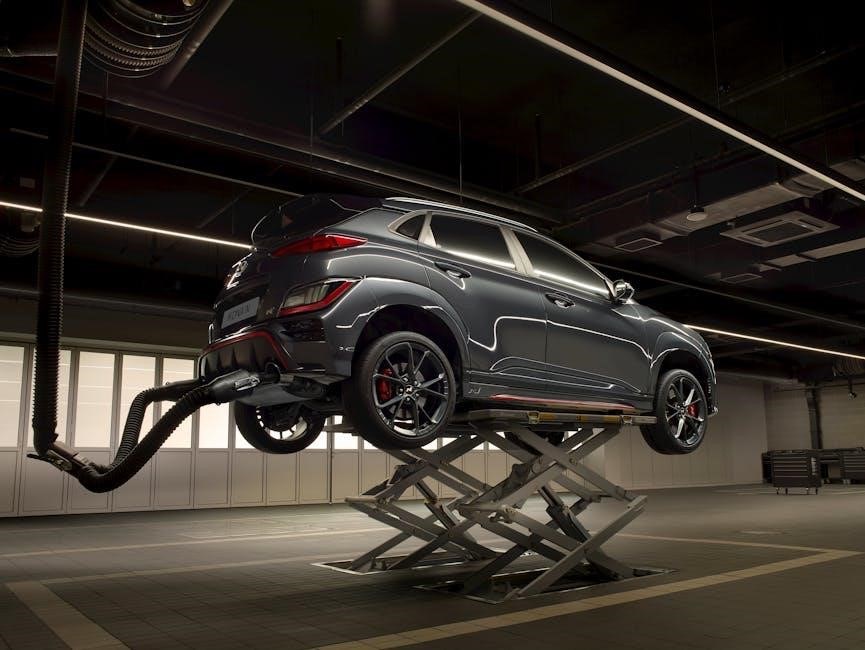
Sanders and Grinders
Sanders and grinders are essential for smoothing and shaping surfaces in auto body repair. Belt sanders and orbital sanders are commonly used to remove imperfections and prepare metal or fiberglass for painting. Grinders, such as angle grinders, are utilized for cutting, grinding, and polishing metal surfaces. These tools are vital for achieving a seamless finish and ensuring proper paint adhesion. Sanders with varying grit levels help transition from coarse to fine sanding, while grinders equipped with abrasive discs handle heavier-duty tasks like rust removal or cutting through metal panels. Proper use of these tools ensures a professional-grade repair outcome.
Drills and Impact Wrenches
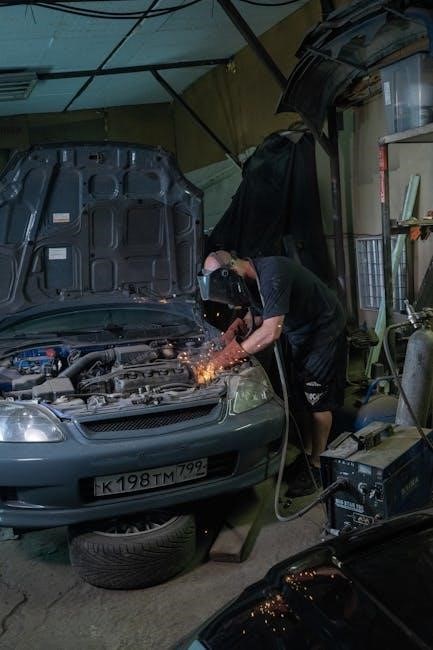
Drills and impact wrenches are indispensable in auto body repair for drilling holes and driving bolts. Cordless drills offer portability, while pneumatic drills provide higher torque for demanding tasks. Impact wrenches, such as 1/2″ or 3/8″ drives, deliver powerful rotational force to loosen stubborn bolts. These tools are crucial for metalwork, disassembling parts, and reassembling vehicles. Proper use ensures efficient repairs, while regular maintenance, like bit replacement and lubrication, prolongs tool life. Their versatility and power make them essential for achieving precise and durable results in automotive restoration and collision repair projects.
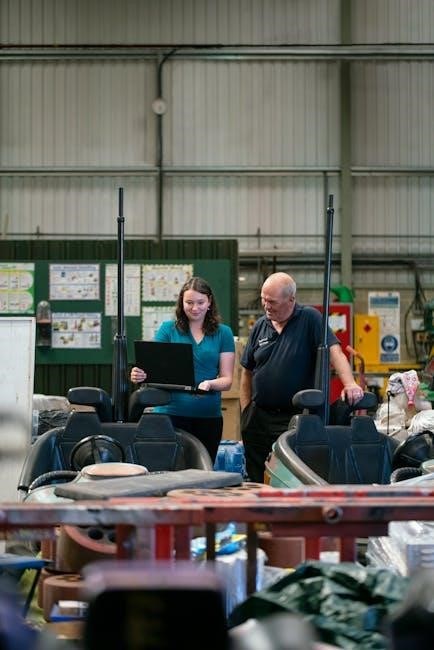
Specialized Tools for Specific Repairs
Specialized tools like dent removal kits and frame straightening equipment are designed for precise repairs. These tools handle specific tasks, ensuring accuracy and efficiency in auto bodywork.

Dent Removal Tools
Dent removal tools are essential for restoring vehicle surfaces without painting. These include stud welders, dent removal kits, and slide hammers. They allow technicians to pull dents smoothly, ensuring minimal damage. Specialized tools like auto-centering devices help remove spot welds efficiently. For small dings, precision tools ensure a flawless finish. These tools are crucial for maintaining the vehicle’s original appearance and structural integrity, making them indispensable in modern auto body repair workflows.
Frame Straightening Equipment
Frame straightening equipment is vital for restoring a vehicle’s structural integrity after collisions. Hydraulic rams and frame machines are commonly used to apply precise force, realigning bent frames. These tools often come with accessories like pulling towers and measuring systems to ensure accuracy. Heavy-duty kits are available for severe damage, while smaller setups handle minor adjustments. Durable materials and robust construction ensure long-term reliability. Proper use of this equipment is critical for maintaining vehicle safety and performance, making it a cornerstone in auto body repair processes.
Paint and Coating Tools
Paint and coating tools are essential for achieving a smooth, durable finish in auto body repair. Spray guns, HVLP (High Volume Low Pressure) systems, and airbrushes are commonly used for precise paint application. Masking materials like tape and paper protect areas not being painted. Sanding blocks and polishing tools prepare surfaces for coating. Specialized equipment, such as paint booths, ensure proper ventilation and even drying. Accessories like paint stirrers and mixing sticks aid in preparation. These tools are crucial for restoring a vehicle’s appearance and protecting its surfaces from environmental damage, ensuring a professional-grade finish every time.
Materials Commonly Used in Auto Body Repair
Materials like metal, wood, and fiberglass are essential in auto body repair. Sheet metal, body panels, and composites are often used to restore vehicles’ structure and appearance.
Metalworking Materials
Metalworking materials are fundamental in auto body repair, including sheet metal, steel, and aluminum. These materials are used to fabricate or repair body panels, ensuring structural integrity. Tools like shears, punches, and welders are essential for shaping and joining metal components. Proper handling and storage of these materials are crucial to maintain their quality and performance in automotive repair projects.
Fiberglass and Composite Materials
Fiberglass and composite materials are widely used in auto body repair for their durability and lightweight properties. These materials often require specialized tools, such as shears, grinders, and resin applicators, to shape and repair damaged areas. Proper techniques, including sanding and layering, are essential to ensure a strong and seamless finish. Adhesives and hardeners are also critical for bonding composite components effectively. Handling these materials with care is vital to avoid damage and achieve professional-grade results in automotive repair projects.
Adhesives and Sealants
Adhesives and sealants play a crucial role in auto body repair, ensuring strong bonds and weatherproofing. Common types include epoxy, acrylic, and silicone-based products, each suited for specific applications. Adhesives are often used for bonding fiberglass, metal, and composite materials, while sealants are applied to prevent leaks and corrosion. Proper surface preparation and application techniques are essential for durability. Environmental factors, such as temperature and humidity, can affect curing times and bond strength. Using the right adhesive or sealant ensures long-lasting repairs and maintains the vehicle’s structural integrity and appearance.
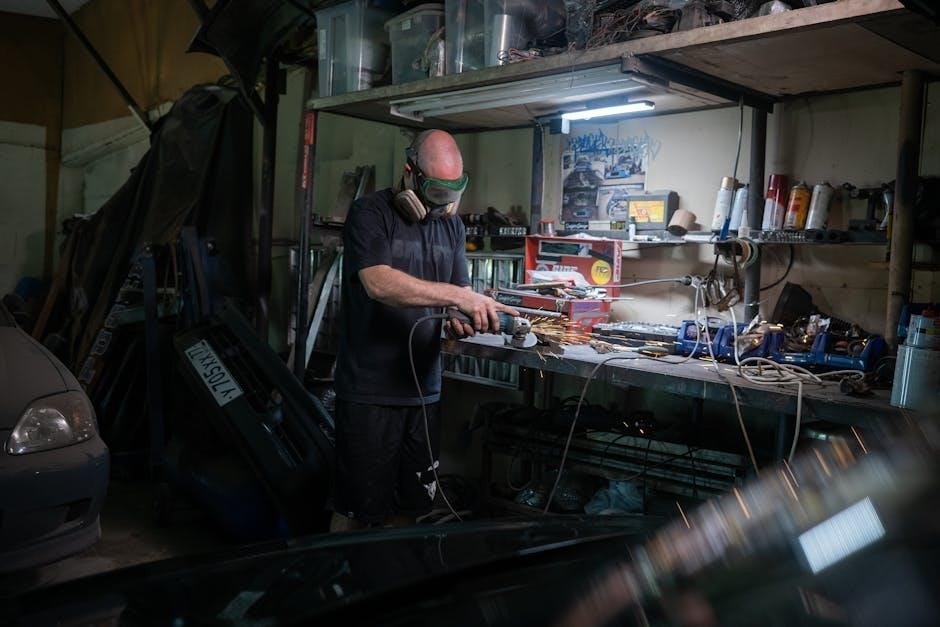
Safety Equipment and Protective Gear
Safety equipment is vital in auto body repair, including gloves, safety glasses, and respirators. Proper ventilation prevents inhaling harmful fumes, while fire extinguishers ensure emergency preparedness.

Personal Protective Equipment (PPE)
Personal Protective Equipment (PPE) is essential for safeguarding against hazards in auto body repair. Safety glasses protect eyes from debris, while gloves prevent cuts and abrasions. Respirators are crucial for filtering harmful fumes from paints and chemicals. Steel-toe boots and high-visibility clothing further enhance safety. Proper PPE ensures compliance with workplace regulations and minimizes risks during welding, grinding, and painting processes. Always inspect PPE for damage before use to maintain effectiveness. A well-equipped technician is better prepared to handle the physical and chemical demands of auto body repair tasks.
Ventilation and Respiratory Protection
Proper ventilation and respiratory protection are critical in auto body repair to prevent inhalation of harmful fumes from paints, solvents, and dust. Workshops should be well-ventilated, with exhaust systems removing airborne contaminants. Respirators with appropriate filters are essential when working with chemicals or sanding materials. Masks rated for organic vapors and dust, such as those from 3M, are commonly recommended. Inadequate ventilation can lead to respiratory issues and long-term health risks. Always ensure good airflow and use respiratory protection to maintain a safe working environment and comply with safety standards.
Fire Safety and Emergency Equipment
Fire safety and emergency equipment are vital in auto body repair shops to prevent and manage potential hazards. Essential items include fire extinguishers rated for flammable liquids, smoke detectors, and emergency exit signs. Workshops should also have first aid kits and eye wash stations to address accidents. Proper storage of flammable materials and regular inspections of electrical systems can reduce fire risks. Emergency equipment should be easily accessible, and staff must be trained in its use. Maintaining a fire-safe environment ensures the protection of personnel, equipment, and facilities, making it a critical aspect of workshop safety protocols.
Best Practices for Tool Maintenance
Regularly clean and store tools to prevent damage. Inspect for wear and tear, replacing worn parts promptly. Organize tools in a designated area for easy access and efficiency.
Cleaning and Storage
Proper cleaning and storage of auto body repair tools are essential for maintaining their performance and longevity. Use mild cleaning solvents to remove grease and grime, ensuring tools are dry before storage. Store tools in a well-organized toolbox or cabinet to prevent damage and misplacement. For larger equipment, designate a specific area to avoid accidental damage. Regularly inspect storage areas for moisture or pests, which can compromise tool quality. Implementing these practices ensures tools remain in optimal condition, ready for use in future repair projects. Cleanliness and organization are key to efficiency and professionalism in any automotive workshop.
Regular Inspection and Replacement
Regular inspection of auto body repair tools and equipment is crucial for maintaining their effectiveness and safety. Inspect tools for signs of wear, damage, or corrosion, and replace them immediately if compromised. Worn-out tools can lead to poor repair quality or accidents. Establish a routine inspection schedule, such as monthly or after heavy use, to identify and address issues early. Keep records of inspections and replacements to track tool condition over time. This proactive approach ensures tools remain reliable, reducing downtime and improving overall workshop efficiency. Regular maintenance also extends the lifespan of equipment, saving costs in the long run.
Calibration and Adjustment
Calibration and adjustment of auto body repair tools and equipment are essential for ensuring accuracy and precision in repairs. Tools like torque wrenches and multimeters require regular calibration to maintain their effectiveness. Adjustments should be made according to manufacturer guidelines to prevent tool malfunction. Proper calibration ensures that repairs meet safety and quality standards, while incorrect settings can lead to costly rework. Regularly check and adjust tools, especially after heavy use or when switching between projects. This practice helps maintain consistency and reliability in the repair process, ensuring optimal performance and extending the lifespan of equipment. Calibration is a critical step in professional auto body repair.

Troubleshooting Common Repair Issues
Identifying and diagnosing problems quickly is crucial in auto body repair. Using the right tools helps resolve issues efficiently, ensuring repairs are done correctly and safely.
Identifying and Diagnosing Problems
Diagnosing issues in auto body repair involves a thorough inspection using specialized tools. Torx sockets and wrench sets help identify misaligned panels or loose components. Metal and fiberglass materials may require specific tools for accurate assessment. Spot weld removal tools and auto-centering devices aid in pinpointing structural damage. Proper diagnostic techniques ensure that repairs are targeted and effective, minimizing the risk of further damage. Using the right tools enhances precision and efficiency in identifying problems, leading to successful outcomes in automotive repair projects.
Tool Malfunction and Repair
Tool malfunctions in auto body repair can hinder progress and require immediate attention. Common issues include worn-out wrenches, damaged Torx sockets, or faulty auto-centering tools. Regular inspection and maintenance are crucial to prevent such problems. When a tool malfunctions, it should be repaired or replaced promptly to avoid further damage. Cleaning, lubricating, and recalibrating tools can often resolve issues. For complex repairs, consulting the manufacturer’s guidelines or seeking professional assistance is recommended. Proper tool maintenance ensures reliability and accuracy in automotive repair tasks, minimizing downtime and ensuring safety.
Material Defects and Solutions
Material defects in auto body repair can arise from improper tool use or poor-quality materials. Common issues include rust on metal panels, cracks in fiberglass, or adhesive failures. To address these, technicians use specialized tools like 3M auto-centering tools for precise repairs. For metal defects, sanding and welding are effective solutions. Fiberglass cracks can be repaired with resin and reinforcement. Adhesive failures often require reapplication with proper surface preparation. Using the right tools and techniques ensures durable and long-lasting repairs, maintaining the vehicle’s structural integrity and appearance. Regular inspection of materials and tools helps prevent such defects, ensuring professional-grade outcomes.

Future Trends in Auto Body Repair Technology
Advancements in materials like metal and fiberglass, coupled with automation and sustainable practices, are revolutionizing auto body repair, enhancing efficiency and reducing environmental impact.
Advanced Materials and Techniques
Modern auto body repair leverages advanced materials like lightweight metals and composites, enhancing durability and reducing weight. Techniques such as laser welding and robotic systems improve precision and efficiency. Fiberglass and composite materials are increasingly used for their strength and versatility. Tools like 3M auto-centering devices simplify spot weld removal, while adjustable centering tools aid in holding sheet metal and body panels. These innovations not only streamline the repair process but also contribute to sustainability by reducing material waste and energy consumption, aligning with industry trends toward eco-friendly practices.
Automation and Robotics
Automation and robotics are revolutionizing auto body repair, enhancing precision and efficiency. Robotic systems now handle tasks like welding, sanding, and painting, reducing human error and speeding up workflows. Advanced tools, such as robotic welding arms, ensure consistent results, while automated sanding systems optimize surface preparation. These technologies also improve safety by handling hazardous materials and reducing physical strain. As automation becomes more prevalent, repair shops can process vehicles faster, meeting growing demand while maintaining high-quality standards. This shift not only modernizes the industry but also aligns with sustainability goals by minimizing waste and energy use.
Environmental Impact and Sustainability
The auto body repair industry is increasingly focusing on sustainability to minimize its environmental footprint. Eco-friendly tools and materials, such as waterborne paints and recycled metals, are gaining popularity. Energy-efficient equipment and waste reduction programs are being implemented in repair shops. Proper disposal of hazardous materials, like chemicals and solvents, is now a priority. Additionally, advancements in tool technology aim to reduce energy consumption and emissions. By adopting sustainable practices, the industry not only protects the environment but also aligns with global efforts to combat climate change, ensuring a greener future for automotive repair.
Conclusion
In conclusion, auto body repair tools and equipment are essential for achieving professional results in vehicle restoration and maintenance. From basic hand tools to advanced power tools, each piece of equipment plays a vital role in ensuring safety, efficiency, and precision. As the industry evolves, there is a growing emphasis on sustainability and eco-friendly practices. By staying informed about the latest tools and techniques, technicians can adapt to changing demands and deliver high-quality repairs. Proper tool maintenance and adherence to safety protocols remain cornerstone principles in this dynamic field, ensuring long-term success and environmental responsibility.

